International Research Journal of Engineering and Technology (IRJET) e-ISSN:2395-0056

Volume: 09 Issue: 09 | Sep 2022 www.irjet.net p-ISSN:2395-0072

International Research Journal of Engineering and Technology (IRJET) e-ISSN:2395-0056

Volume: 09 Issue: 09 | Sep 2022 www.irjet.net p-ISSN:2395-0072
1-5 Student, Civil engineering Department, Sree Narayana Institute of Technology, Adoor, India 6 Assistant Professor, Civil engineering Department, Sree Narayana Institute of Technology, Adoor, India
Abstract - Cement is a major binding component in concrete. It is of great importance in construction industry. Even though cement has these prominent properties, it emits carbon dioxide. So ferrock is used as an alternative for cement. Ferrock is an innovative iron-based binding compound, which presents a carbon-negative alternative to cement that utilizes a variety of waste streams to produce a versatile building material. Ferrock is a binder that is a blend of iron oxide powder, fly ash, lime powder, metakaolin and oxalic acid. Oxalic acid act as a catalyst. Iron oxide reacts with carbon dioxide and water produces iron carbonate. It can enhance the environment by absorbing the atmospheric carbon dioxide for its hardening process. By the use of ferrock the rate of emission of most dangerous greenhouse gases are reduced. During the curing process, carbon dioxide is used instead of traditional water curing. This helps in reducing the usage of water.
Key Words: Ferrock, oxalic acid, carbon dioxide absorption, carbon, cement replacement, waste management,carbonnegative
Infrastructuredevelopmentisresultinginalinearincrease intheconstructionofmulti-storiesorhigh-risebuildings, roads, bridges, towers, etc. The foremost vital material utilized in this construction is that the cement. Cement is thatthebindingmaterialaccustomedtogainstrengthsoas to sustain the weight applied on that, it is associated by artificial means of factory-made product that releases carbon dioxide within the method of its manufacture that contributestotheentireatmospherebymoreorlessabout 6to8%.Thisproposestogaugethepowerofferrocktobe used jointly as the simplest doable substitutes for cement inconcrete.Itismostlyassociatedwithironbasedbinding compoundthatutilisesdifferenttypeofwastematerialsto makeacarbonnegativeartefact.
Cementinconcreteisthat,thesecondmostused entity when. Water in the world nowadays, is that the fourth largest supply of phylogenies carbon emissions. The
worlds infatuation with this high carbon intensive material has full-grown to be real pandemic, because the accumulation of those emissions contributes to the growingthreatofworldwideclimaticallycatastrophe.
Ferrock is associated with an iron-based binding compound that is manufactured from 95% of recycled materials thatare tried to be less-expensive, stronger and additional versatile in its building applications than ordinary Portland cement. Ferrock in original type has 5 time’s additional compressive strength and flexures far beforefailureincomparisontomanagethecombinationof control mix. For winding up the overall replacement of cement the most demand may be a 100% greenhouse emissionatmosphereforcuring.Furthermore,thisbuilding material uses compressed carbon dioxide to expedite the curing process and requires no added heat to catalyse its chemical reaction making it a carbon negative alternative to ordinary Portland cement. Ferrock is a binder that is a blend of iron oxide, fly ash, lime powder, metakaolin and oxalicacid.Oxalicacidactasacatalystandonreactionwith carbondioxideandwaterproducesironcarbonates,which isthehardest.Ferrockinvolvesacuringprocess.Ferrockis thus a more promising eco-friendlier binding material in termsofitscarbonnegativityandinbestusageofthewaste.
TodeterminethecompressivestrengthofFerrock
To determine the mechanical properties of ferrockcementconcreteusingwatercuringand carbondioxidecuring.
To determine durability properties of ferrock cementconcreteusingwatercuringandcarbon dioxidecuring.
Tocomparecuringofferrockcementconcrete usingwatercuringandcarbondioxidecuring.
Ferrock production shows an intriguingopportunity for future applications, especially as the energy industrylooksforalternativesourcesoffuel.
International Research Journal of Engineering and Technology (IRJET) e-ISSN:2395-0056

Volume: 09 Issue: 09 | Sep 2022 www.irjet.net p-ISSN:2395-0072
Ferrock have been represented as an extremely enticing,buttheambiguityofitsuniqueproperties hasthepotentialtohaveamuchgreaterimpacton the sustainable well-being of the abode and the prosperityofhumanadvancement.
Focussingoncarbonemissionreductionaswellas utilization of waste materials to produce a better environment.
Development of new engineered cementitious materialwhichhasmorefutureopportunities.
Ferrock isa better alternativeto conventional concrete. It acts as a waste management tool, wherever within the waste is being best utilized. The raw materials which is employed in the production of ferrock when used in different proportions to get the best use of it in terms of strength. The major ingredient in the ferrock is the iron oxidepowder.Othercomponentsofferrockareusedbased onitscomparisonwiththatofcementasthisproductisan alternative to cement in many purposes, and also its compatibility with other materials for construction. The strength gaining mechanism of ferrock is by consumption of carbon dioxide that reacts with the iron and forms the iron carbonate that adheres powerfully to the substrate. Now, in case of ferrock the curing process conducted is carbon dioxide curing. It is noted that carbon curing of 4 daysandaircuringof3dayswillgivebesttestresult.Water is simply for transferring and intermixture of the raw materials incontrasttocementthatusesitthroughoutits strength gaining activity, the curing process.A product named ferrock is a binder material used as a partial or completereplacementtocementin concrete.Ferrock was measuredbasedonitstestingwithdifferentproportionsof the raw materials. The composition of ferrock was concluded as 60% iron powder, 20% flyash, 10% metakaolin, 8% limestone, 2% oxalic acid in terms of rheological characteristics.The pore and micro structural propertiesofthebetterperformingmaterialwasconcluded asferrock.
In order to contrast the environmental effects of ordinary Portland cement and ferrock especially aiming on their contribution to carbon pollution, water use, energy consumption.Bysubstitutingpartiallyferrockwithcement invariedproportionsas4%,8%,12%inconcreteoptimum ratio of replacement which would give better strength in terms of sustainability. And hence a new product called FerrockCementConcreteevolved.
In the first mix 4% ferrock by weight of cement (96%) is used as a substitute. Similarly 8% ferrock by weight of cement (92%) is used as a substitute and also 12% of ferrockbyweightofcement(88%)isusedasasubstitute. The maximum strength of concrete is obtained at 8% of replacement of ferrock by weight of cement. Ferrock cementconcreteisastrongerbindingmaterialthathelpsto increasethebondstrengthoftheconcretemixwithoutany failure.Thestrengthgainingmechanismofferrockcement concreteisbybothaircuringandwatercuring.Aircuring is mainly done by using carbon dioxide gas in an air tight container or plastic cover and carbon dioxide gas is introducedinit.
Table -1: Percentageofmaterialsaddedinferrock
Materials Percentage{byweight}
Ironoxidepowder 60% Flyash 20% LimestonePowder 10% Metakaolin 8% WeakOxalicAcid 2%
Iron oxide powder: Iron oxide particles as produced for the construction industry, are 10 times finer than cement particles. When added into a concrete mix, the iron oxide particles actually surround and coat the cement particles. This iswhyintegralcolour isdosed or meteredbasedonthe cement content, not on the amount of sand, stone or water. Iron oxide powder is examined and stated that they are elongated and angular in shape. However, the large surface areahelpingittoprovidegreaterreactivity.
e-ISSN:2395-0056
Volume: 09 Issue: 09 | Sep 2022 www.irjet.net p-ISSN:2395-0072

Metakaolin: Metakaolin is a high-quality pozzolanic material. Metakaolin is one of the most widely used admixtures these days. It helps concrete to obtain both higherperformanceandeconomy.Itisproducedfromhigh Kaolin.Metakaolinconsistofsilicaandaluminainanactive form and as other mineral admixtures, it reacts with calciumhydroxideatroomtemperatureandformcalcium silicatehydrate-gelwhichincreasesthedensityofconcrete andreducesporosity.
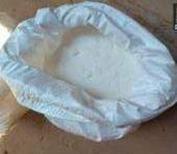
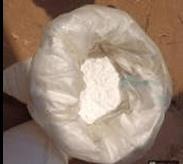

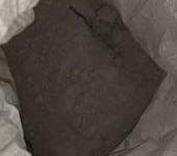
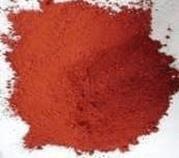
FlyAsh:Flyashisa by-productora wasteproduct,hence use of fly ash concrete reduces CO2 and is thus is environment friendly.It hasgood cold weather resistance and non-shrink material. Fly ash concrete has great workability as well and allows for a lower water-cement ratiosimilarslumpscomparedtotheordinaryconcrete.It reducesheatofhydration,cracks,permeability,bleeding.It iscost-effectivesubstituteforPortlandcement.



OxalicAcid:Oxalicacidisaweakacidandisreportedtoact asanaccelerator for cementhydration reaction.Thismay also be helpful in the formation of a protective electrical double-layer film around the cement particle during gel state.
Limestonepowder:Additionoflimestonepowderprovides easier grindability, reduced water demand, increased strengthandlessbleedinginconcrete.Limestoneduetoits reactive nature provides nucleation sites for clinker hydrationproducts,andreducesheatofhydration.Bending ofLimestoneincementwillreducetheemissionofCO2 and addition of limestone will improve workability of cement. Limestonepowderisaby-productofthelimestonequarry, andithasbeenusedincement-basedmaterials.Limestone can be formed from marine organisms, lacustrine and evaporatedepositionalenvironments.
Carbondioxide: Thecuring ofconcreteelements bydiffusing carbon dioxide into it under controlled pressure and temperature is one of the popular methods of accelerated curing. In ferrock concrete and ferrock cementconcrete CO2 curing is more beneficial. Iron oxide powder reacts with carbon dioxide to form iron carbonate which gives binding abilitytoferrock.
The accepted reaction steps for this process are: Fe
+2CO2+H2O Fe2+ +2HCO3 - +H2
Fe2+ +2HCO3 - FeCO3 +CO2 +H2O
Thenetreactionthenis
Fe+CO2 +H2O FeCO3 +H2
International Research Journal of Engineering and Technology (IRJET) e-ISSN:2395-0056

Volume: 09 Issue: 09 | Sep 2022 www.irjet.net p-ISSN:2395-0072
Specificgravityisdefinedastheratiobetweenweightofa givenvolumeofmaterialandweightofanequalvolumeof water. To calculate specific gravity for any material, we havetousewater.Butwaterreactswithcementandforms calcium oxide. So that we are using Kerosene. It doesn’t react with cement. The specific gravity of the ferrock mix obtained after testing was 1.36 which is less compared to ordinaryPortlandcement.
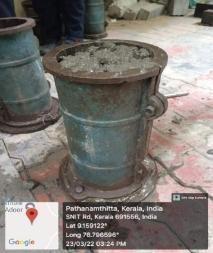
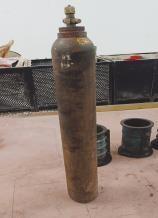
Fig -6:Carbondioxidegas

Inthisprojectwork,53gradeofOrdinaryPortlandCement is used. As per the Indian Standard the different tests are done for the accuracy such as Fineness Test, Consistency Test,SpecificGravity,IntialandFinalSettingtime.
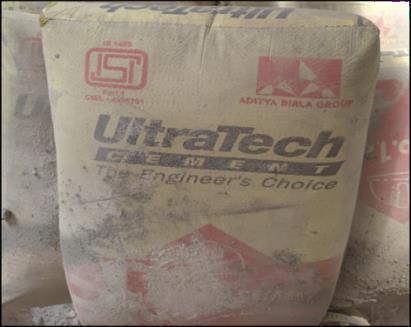
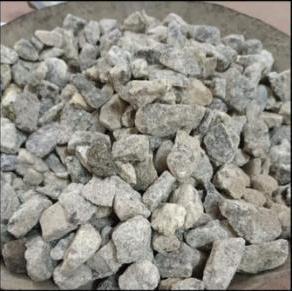
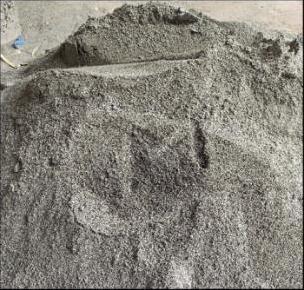
The fineness of ferrock mix was determined using 90 micron sieve and found that 0 percent of the particles retainedwithinthe90micronsieve.
6.1 Coventional
W/Cratio=0.50 MixRatio=1:1.9:3.1(cement:sand:aggregate)
6.2 Ferrock
W/Cratio=0.5 MixRatio=1:1:2(ferrock:sand:aggregate)
Fig -7:Cement
Aggregateisoneofthemostimportantingredientofthe concretewhichisresponsibletoprovidethestrengthto thestructure. To get the best result we used angular aggregateandastheIndian CodalProvisionswedidthe tests such Specific Gravity, Fineness modulus. Fine aggregate used is M Sand. Coarse aggregate of 20mm sizeisused.
Casted conventional concrete of M25 mix design and the mix raito is 1:1.9:3.1 (cement:sand: aggregate). After mixing the conventional concrete mix was casted into moulds of different cubes, cylinders and beams and Compressive strength test, Splitting tensile strength test, Flexuralstrengthtestonconventionalconcretearetested. Conventionalconcreteiscuredusingwater.
Fig –9:Castingofconventionalconcrete
International Research Journal of Engineering and Technology (IRJET) e-ISSN:2395-0056

Volume: 09 Issue: 09 | Sep 2022 www.irjet.net p-ISSN:2395-0072
Casted ferrock concrete of M25 mix design and the mix ratio is 1:1:2 ( ferrock:sand: aggregate). After mixing the ferrock mix was casted into moulds of cube size 150mm*150mm*150mm. Ferrock concrete is cured using carbonation. CO2 gas is passed through the mix for curing usingspecialsetups.Byabsorbingcarbondioxideforlong time, the ferrock material will get strengthened more. Curing process is one of the major difference between conventional concrete and ferrock concrete. In conventionalconcretelotsofwaterisbeingusedformixing andcuringprocess.Butinferrockconcretewaterusagefor curingisless.
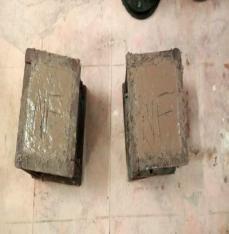
Fig -11:Castingofferrockcementconcrete
8.1 Conventional concrete
Table -2: Coventionalconcretetestvalues
TESTS DAY7 DAY14 DAY28 Compressiv eStrength Test (N/mm2)
23.55N/m m2 24.44N/m m2 26.22N/m m2
Fig -10:Castingofferrockconcrete
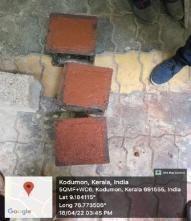
In the basic mix, cement:fine aggregate:coarse aggregate was in a ratio of 1:1.9:3.1 for M25 grade concrete. In the first mix, 4% of ferrock by weight of cement is used as substitute. Similarly, 8% and 12% of ferrock powder is substitutedbyweightofcement.Withthehelpofmixratio the weight of all materials are calculated for mixing concreteinrequiredvolumesforallthespecimensofcube size 150mm*150mm*150mm size, split tensile cylinder size 300mm*150mm and flexural beam of 100mm*150mm*150mm has been casted as per decided percentage substitution.The casted specimen have been kept for 24hrs in a dry place for making harden concrete and the removed from mould. After remolding the specimensithastokeepcuringinwaterandcarbondioxide for 7,14,28 days. After curing the specimen is taken out from curing tank and dried for few hours to remove the moisture content. The dried specimen is to be tested for compressive strength, split tensile and flexural strength. Theresultsofsubstitutedspecimenshavebeencompared toconventionalconcretewithoutsubstitution.Ithasgiven avalueatwhichpercentageofferrockinconcretereaches itsmaximumstrength.Theoptimumdosagehasbeennoted fromtheexperimentalresult.
Splitting Tensile Strength Test(N/mm 2)
Flexural Strength Test (N/mm2)
2.12N/mm2 2.2N/mm2 2.55N/mm2
2.35N/mm2 2.81N/mm2 3.3N/mm2
8.2 Ferrock concrete
Table -3:Compressivestrengthtestvaluesofferrock
TESTS DAY7 DAY14 DAY28 Compressive Strength Test (N/mm2)
2.3N/mm2 2.57N/mm2 2.68N/mm2
International Research Journal of Engineering and Technology (IRJET) e-ISSN:2395-0056

Volume: 09 Issue: 09 | Sep 2022 www.irjet.net p-ISSN:2395-0072
Table -4: Compressivestrengthtestvaluesofferrock cementconcreteinCO2 curing
Percentage replaced (%)
Compressive strength after7days (N/mm2)
Compressive strength after14days (N/mm2)
Compressive strength after28days (N/mm2)
4% 21.86 27.83 35.24 8% 22.13 29.24 36.94 12% 21.1 26.43 32.61
Table -5: Compressivestrengthtestvaluesofferrock cementconcreteinwatercuring
Percentag ereplaced (%)
Compressiv estrength after7days (N/mm2)
Compressiv estrength after14 days (N/mm2)
Compressiv estrength after28 days (N/mm2)
4% 20.1 26.1 34.2 8% 20.16 28.2 35.3 12% 19.3 25.1 30.01
Table -6: SplittingTensilestrengthtestvaluesofferrock cementconcreteinCO2 curing
Percentag ereplaced (%)
Compressiv estrength after7days (N/mm2)
Compressiv estrength after14 days (N/mm2)
Compressiv estrength after28 days (N/mm2)
4% 2.52 2.83 3.24 8% 2.63 2.94 3.42 12% 2.41 2.56 2.75
Table -7: SplittingTensilestrengthtestvaluesofferrock cementconcreteinwatercuring
Percentag ereplaced (%)
Compressiv estrength after7days (N/mm2)
Compressiv estrength after14 days (N/mm2)
Compressiv estrength after28 days (N/mm2)
4% 2.14 2.32 3.1 8% 2.5 2.81 3.4 12% 2.11 2.32 2.51
Table -8: SplittingTensilestrengthtestvaluesof ferrockcementconcreteinCO2 curing
Percentag ereplaced (%)
Compressiv estrength after7days (N/mm2)
Compressiv estrength after14 days (N/mm2)
Compressiv estrength after28 days (N/mm2) 4% 2.94 3.23 4.24 8% 3.24 3.76 4.42 12% 2.41 2.96 3.45
Table -9: Flexuralstrengthtestvaluesofferrock cementconcreteinwatercuring
Percentage replaced (%)
Compressive strength after7days (N/mm2)
Compressive strength after14days (N/mm2)
Compressive strength after28days (N/mm2)
4% 2.15 3.01 4.02 8% 3.11 3.53 4.01 12% 2.22 2.53 3.1
International Research Journal of Engineering and Technology (IRJET) e-ISSN:2395-0056

Moisture penetration is one of the factors affecting the durabilityofconcrete.Concreteasaporousmaterialwhich can allow water to migrate through it, corroding steel reinforcement, bringing in harmful chemicals. So it is a predominantfactortobedeterminedtoassesthequalityof concrete.Forwaterabsorptiontest,cubespecimenofsize of 150mm*150mm*150mm was casted and immersed in water and carbon dioxide curing for 28 days. The specimens are ovendried for 24 hours at the temperature of110degreeCelsiusuntilthemassbecomesconstantand againweighedatroomtemperature.
%waterabsorption=(W1–W2)/W2*100
W1=ovendriedweightofspecimen
W2=finalweightofspecimen
Table -10:Waterabsorptiontestvaluesincarbondioxide curing
Sl.No. Before immersion (kg)
After immersion (kg)
Percentageloss inweight
1 8.310 8.415 1.26 2 8.211 8.302 1.11 3 8.101 8.302 1.50
Table -11:Waterabsorptiontestvaluesinwatercuring
Sl.No. Before immersion (kg)
After immersion (kg)
Percentageloss inweight
1 8.150 8.310 1.96 2 8.112 8.232 1.48 3 7.99 8.119 1.61
5% sodium sulphate (Na2SO4) by volume solution were preparedandthreecubesofsize150mm*150mm*150mm were immersed in solution after 28 days curing in water and carbon dioxide for taking 28 days after taking intial weights. The cubes were weighted and tested on compressiontestingmachineafter28days.
%lossinweight=(W1–W2)/W2*100
W1=ovendriedweightofspecimen W2=finalweightofspecimen
Table -12:Sulphatetestvaluesincarbondioxidecuring
Sl.No. Before immersion (kg)
After immersion (kg)
Percentageloss inweight
1 8.337 8.373 0.431
2 8.327 8.363 0.432 3 8.405 8.441 0.421
Table -13:Sulphatetestvaluesinwatercuring
Sl.No. Before immersion (kg)
After immersion (kg)
Percentageloss inweight
1 8.404 8.440 0.428 2 8.334 8.370 0.431 3 8.324 8.360 0.432
Volume: 09 Issue: 09 | Sep 2022 www.irjet.net p-ISSN:2395-0072 © 2022, IRJET | Impact Factor value: 7.529 | ISO 9001:2008 Certified Journal | Page861
Ourstudycomparestheenvironmentalimpactsofordinary Portland cement and ferrock (iron oxide powder-60%, flyash-20%, metakaolin -12%, and limestone-8% ) focussing specially on their contributionto carbon pollution, water use and energy consumption.By substitutingcementwithferrockinvaryingproportionsas 4%, 8%, and 12% in concrete we are trying to find the optimum ratio of replacement which would give desired results in both strength( compressive, split tensile & flexuralstrength).Inallthetestresults8%showsthegood result in strength. It is also seen that Specific gravity of ferrock mix is less than specific gravity of cement.Ferrock cube achieved amaximum compressive strength of 2.68 N/mm2only. This is due to the variation in particle sizeof iron powder and environmental condition. From the test resultsitisseenthatmechanicalstrengthofferrockcement concrete is greater than that of conventional concrete. In ferrockcementconcrete,8%replacementofcementshows increaseinstrength.Theferrockcementconcretewasboth watercuredandCarbondioxidecured.CO2 curingisbetter thanwatercuringinferrock cementconcrete.Tosavethe environment, ferrock is the better partial substance as replacementofcementinconcrete.
International Research Journal of Engineering and Technology (IRJET) e-ISSN:2395-0056 Volume: 09 Issue: 09 | Sep 2022 www.irjet.net p-ISSN:2395-0072

[1] Niveditha M, Y M Manjunath, Setting H S Prasanna (2021), “Ferrock: A Carbon Negative Sustainable Concrete” International Journal of Sustainable Construction EngineeringandTechnology,Vol.11,26July,pp.90-98.
[2] S. Karuppasamy, Kethepalli Dinesh Kumar, Kotla Janardhan Reddy (2021) “Experimental Study on Ferrock” International Journal of Scientific Research in Science, EngineeringandTechnology,Vol.8,May,pp.220-302.
[3] Vijayakumar Y.M, Seema B.S,(2021) “ Review on Carbondioxide Curing of Concrete” International Journal of Engineering Applied Sciences and Technology, Vol.5, July, pp.171-174.
[4]MKantaRao,NagaSatishKumar(2021) “Evaluation of Strength Properties of the Concrete Prepared from Class F Flyash” Earth and Environmental Science, Vol.982, September,pp.125-137.
[5]YogeshPawar,ShrikantRajendraKate(2021) “Curing of concrete: A Review” International Research Journal of EngineeringandTechnology,Vol.7,August,pp.1820-1824.
[6]VrajeshMPatel,HardikJSolank(2020) “Development of Carbon Negative Concrete by Using Ferrock” International Journal of Sustainable Construction Engineering and Technology,Vol.12, July,pp.111-119
[7] Shanmugasundaram, Gokul Vvs, Mouli Prashanth Prakasam(2019) “Investigation on Ferrock Based Mortar an Environment Friendly Concrete” International Research Journal of Engineering and Technology, Vol.6, September, pp.467-469.
[8] D.S. Vijayan, Dinesh Kumar, S. Aravindan, Thattil ShreelakshmiJanarthanan(2019) “Evaluation of Ferrock: A greener substitute to Cement” MaterialsTodayProceedings, Vol.8,October,pp.171-178.